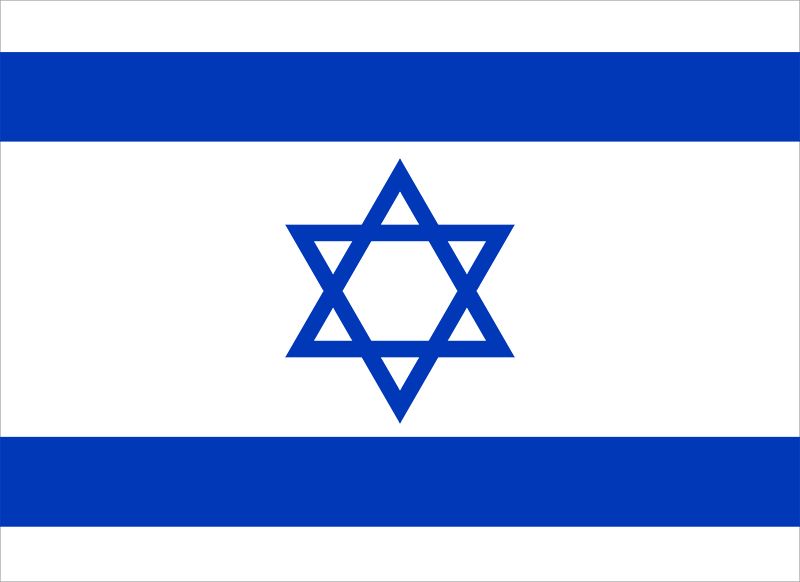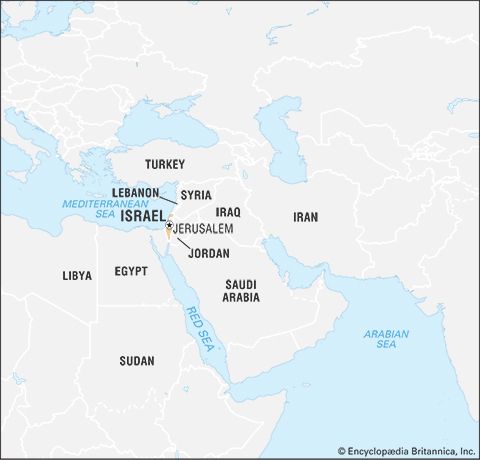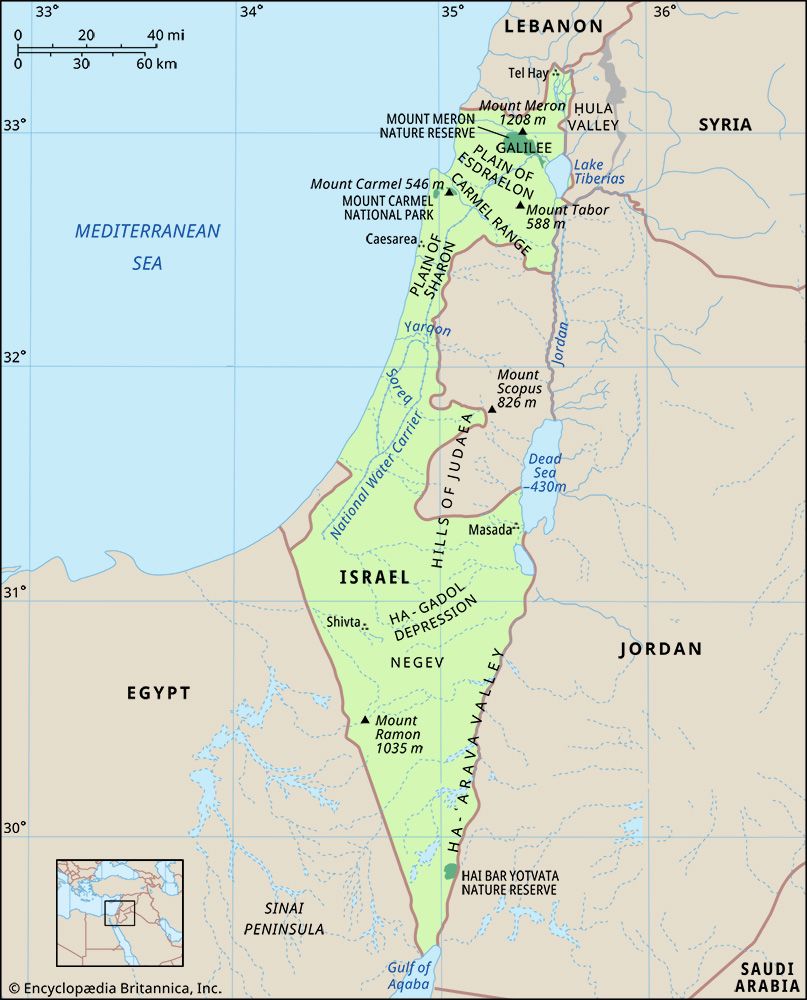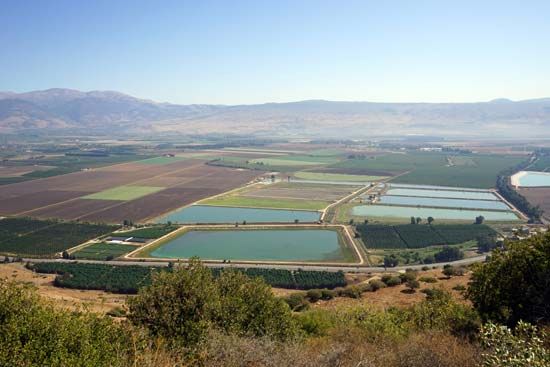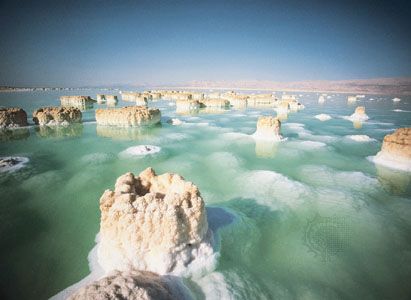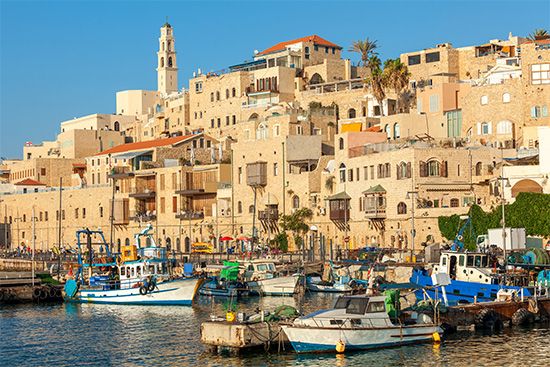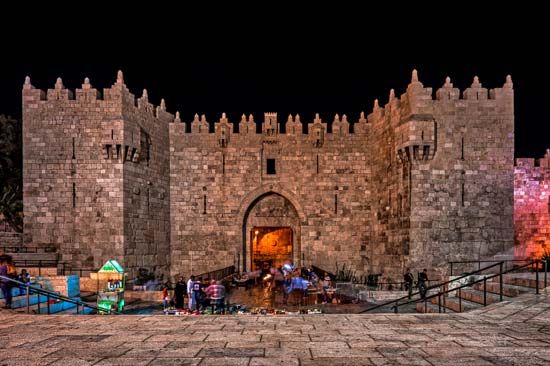Our editors will review what you’ve submitted and determine whether to revise the article.
News •
For more than 40 years local demand fueled Israeli industrial expansion, as the country’s population grew rapidly and the standard of living rose. More recently, world demand for Israeli advanced technologies, software, electronics, and other sophisticated equipment has stimulated industrial growth. Israel’s high status in new technologies is the result of its emphasis on higher education and research and development. The government also assists industrial growth by providing low-rate loans from its development budget. The main limitations experienced by industry are the scarcity of domestic raw materials and sources of energy and the restricted size of the local market.
Mining and quarrying
The country’s mining industry supplies local demands for fertilizers, detergents, and drugs and also produces some exports. A plant in Haifa produces potassium nitrate and phosphoric acid for both local consumption and export. Products of the oil refineries at Haifa include polyethylene and carbon black, which are used by the local tire and plastic industries. The electrochemical industry also produces food chemicals and a variety of other commodities. Oil pipelines run from the port of Eilat to the Mediterranean. Israel has some producing oil wells but continues to import most of its petroleum.
Manufacturing
Industrial growth has been especially rapid since 1990 in high-technology, science-based industries such as electronics, advanced computer and communications systems, software, and weapons, and these have come to command the largest share of overall manufacturing output. Other principal products include chemicals, plastics, metals, food, and medical and industrial equipment. Israel’s diamond-cutting and polishing industry, centred in Tel Aviv, is the largest in the world and is a significant source of foreign exchange. The great majority of industries are privately owned, one exception being the government-run Israel Aircraft Industries, Ltd., a defense and civil aerospace manufacturer. Factories producing military supplies and equipment have expanded considerably since the 1967 war—a circumstance that stimulated the development of the electronics industry.
Services
Finance
Israel’s central bank, the Bank of Israel, issues currency and acts as the government’s sole fiscal and banking agent. Its major function is to regulate the money supply and short-term banking. The Israeli currency was devalued numerous times after 1948, and the new Israeli shekel (NIS) was introduced in September 1985 to replace the earlier Israeli shekel. The government and central bank introduced this measure as part of a successful economic stabilization policy that helped control a rate of inflation that had grown steadily between the 1950s and mid-1980s and had skyrocketed in the 1970s.
Israel has commercial (deposit) banks, cooperative credit institutions, mortgage and investment credit banks, and other financial institutions that are supervised by the central bank. The banking system shows a high degree of specialization. Commercial banks are privately owned and generally are restricted to short-term business. Medium- and long-term transactions, however, are handled by development banks jointly owned by private interests and the government, which cater to the investment needs of different sectors of the economy: agriculture, industry, housing, and shipping. The Tel Aviv Stock Exchange was established in 1953.
Tourism
Tourism has increased significantly and has become an important source of foreign exchange, although its growth at times was affected by regional strife. Visitors are drawn to Israel’s numerous religious, archeological, and historic sites—such as the Western Wall and the Dome of the Rock and biblical cities such as Nazareth, and Bethlehem in the West Bank—as well as to its geographic diversity, excellent weather for leisure activities, and links to the Jewish and Palestinian Arab diasporas. There are numerous resorts in the highlands and desert and along the coast, with most tourists coming from Europe and a growing number from North America.
Trade
Access to foreign markets has been vital for further economic expansion. Israel has free trade agreements with the European Union and the United States and is a member of the World Trade Organization. These agreements and Israel’s many industrial and scientific innovations have allowed the country to trade successfully despite its lack of access to regional markets in the Middle East. A central problem, however, has been the country’s large and persistent annual balance-of-trade deficit.
Imports consist mainly of raw materials (including rough diamonds), capital goods, and food. Exports more than doubled in value through the 1990s and became highly diversified, originating in all the major manufacturing sectors and in agriculture. High-technology products led the list of exports, and Israel sells fruit (including citrus), vegetables, and flowers throughout Europe during the off-season. Its biggest trade partners are the U.S. and China.
Transportation
Israel has developed a modern, well-marked highway system, and road transport is more significant to the country’s commercial and passenger services than transport by rail. Bus companies provide efficient service within and between all cities and towns, supplemented by private taxis and sheruts—privately owned and operated shuttles—which run on urban and interurban routes. Sheruts also operate on Saturdays, when much of the regular rail and bus service is suspended in observance of the Sabbath.
Shipping is a vital factor both for the economy and in communications with other countries. As a result of the closing of the land frontiers following the Arab blockade of Israel, ocean and air shipping has played a major role in the transportation of supplies. Three modern deepwater ports—Haifa and Ashdod on the Mediterranean and Eilat on the Red Sea—are maintained and developed by the Israel Ports and Railways Authority and are linked to the country by a combined road and rail system. Israel’s shipping access routes to both the Atlantic and Indian oceans have stimulated a continuous growth of its merchant fleet and airfreight facilities.
Ben Gurion International Airport in Lod is the country’s largest. Regular flights are maintained by several international airlines, with EL AL Israel Airlines Ltd., Israel’s national carrier, accounting for the largest share of the traffic. Scheduled domestic aviation and charter aviation abroad is operated by Arkia Israeli Airlines Ltd. Airports at Jerusalem, Tel Aviv, Eilat, Rosh Pinna, and Haifa serve the country’s domestic air traffic.
Government and society
Constitutional framework
Israel does not have a formal written constitution. Instead, its system of government is founded on a series of “basic laws” plus other legislation, executive orders, and parliamentary practice. The basic laws are a political compromise that serve as an alternative to a constitution. They are passed in the same way as other pieces of legislation but are intended to serve as guiding principles of the state. While it remains unclear whether the basic laws in fact hold superiority over other laws, Israel’s High Court of Justice has historically ruled against laws that have contradicted the basic laws.
The country is a democratic republic with a parliamentary system of government headed by a prime minister and involving numerous political parties representing a wide range of political positions. Israel’s lawmaking body, the Knesset, or assembly, is a single-chamber legislature with 120 members who are elected every four years (or more frequently if a Knesset vote of nonconfidence in the government results in an early election). Members exercise important functions in standing committees. Hebrew, the country’s official language, and Arabic, legally recognized as holding special status, are used in all proceedings.
The country’s prime minister is the head of government and is entrusted with the task of forming the cabinet, which is the government’s main policy-making and executive body. Israel has a strong cabinet, and its members may be—but need not be—members of the Knesset.
The president, who is the head of state, was traditionally elected by the Knesset for a five-year term that could be renewed only once; beginning in 2000, however, presidents were elected for a single, seven-year term. The president has no veto powers and exercises mainly ceremonial functions but has the authority to appoint certain key national officials, including state comptroller, governor of the Bank of Israel, judges, and justices of the Supreme Court.
The state comptroller—an independent officer elected by the Knesset before being appointed by the president—is responsible only to the Knesset and is the auditor of the government’s financial transactions and is empowered to inquire into the efficiency of its activities. The comptroller also acts as a national ombudsman.
Israel’s civil service gradually has become a politically neutral and professional body; previously, it tended to be drawn from, and to support, the party in power. The government’s extensive responsibilities and functions have acted to enlarge the bureaucracy.
Local and regional government
The country is divided into 6 districts—Central, Jerusalem, Haifa, Northern, Southern, and Tel Aviv—and into 15 subdistricts. Local government consists of municipalities, local councils (for smaller settlements), or regional rural councils. The bylaws of the councils, as well as their budgets, are subject to approval by the Ministry of the Interior. Local government elections are held every five years.
Political process
National and local elections in Israel are by universal direct suffrage, with secret balloting. All resident Israeli citizens are enfranchised from age 18, regardless of religion or ethnicity, and candidates for election must be at least 21 years old. For national races, the system of election is by proportional representation, and each party receives the number of Knesset seats that is proportional to the number of votes it receives.
Israel’s party system has traditionally been complex and volatile: splinter groups are commonly formed, and party alliances often change. Cabinets are therefore invariably coalitions, often of broad political composition, since no single party has ever been able to obtain an absolute majority in the Knesset. Electoral reform in 1992 brought about two significant changes: direct election of the prime minister—formerly the de facto head of government by dint of being leader of the governing coalition—and primary elections to choose lists of party candidates. The primary system enhanced participatory democracy within the parties, while the prime ministerial ballot increased the power of smaller parties, further splintering the composition of the Knesset and making governing coalitions more difficult to maintain. As a consequence, Knesset representation among the two traditional major parties, Labour and Likud, diminished.
Direct elections for the premiership were repealed in 2001, and Israel returned to its earlier practice, in which the governing coalition’s leader sits as prime minister. Despite the change, the two main parties continued to face challenges, not only from minor parties but also from new ones. Since the 2001 reform, a number of newly formed parties centred on strong personalities—such as Kadima (Ariel Sharon), Yesh Atid (Yair Lapid), Hatnua (Tzipi Livni), and Kulanu (Moshe Kahlon)—have played prominently in most elections.
Political parties are secular or religious: the Jewish secular parties are Zionist and range in orientation from left-wing socialist to capitalist, and the religious parties tend to have ethnic appeal (Sephardi or Ashkenazi). There are also several small parties that represent primarily Arab constituents. After the election threshold for representation in the Knesset was raised in 2014, the Arab parties and the multiethnic Hadash party ran on a single list in 2015 (as the Joint List) and became the third largest group in the Knesset. Labour, meanwhile, formed its own list (the Zionist Union) with Hatnua and the Green Movement in order to maximize gains against the right-wing coalition and earned second place in the elections for the first time since 2006.
Israeli citizens take an active interest in public affairs above and beyond membership in political parties. The pattern of Israel’s social and economic organization favours participation in trade unions, employers’ organizations, and interest groups concerned with state and public affairs.
Occupation of Arab territories
After the 1967 war, Arab territories occupied by Israeli forces were placed under military administration. These included the territory on the west bank of the Jordan River (the West Bank) that had been annexed by Jordan in 1950, the Gaza Strip, the Sinai Peninsula region of Egypt, and the Golan Heights region of Syria. In addition, East Jerusalem (also formerly part of Jordan) was occupied by Israeli forces, and Israel took over administration of the city as a single municipality; in 1967 Israel incorporated East Jerusalem and adjoining villages and later formally annexed them—actions that have continued to be disputed abroad and hotly contested by Palestinians and neighbouring Arab nations. In 1978 the Israeli military occupied a strip of Lebanese territory adjoining Israel’s northern border, from which it withdrew in 2000. Israel passed legislation effectively annexing the Golan Heights in April 1981, but completed a withdrawal from the Sinai Peninsula in April 1982 after negotiating a peace treaty with Egypt. Likewise, in May 1994, Israel began turning over control of much of the Gaza Strip and parts of the West Bank—including jurisdiction over most of the people in those areas—to the Palestinians in accordance with the provisions set forth in the Cairo Agreement on the Gaza Strip and Jericho signed by the two parties earlier that month. These exchanges of territory were part of a series of agreements (generally referred to as the Oslo Accords) that were initiated by the September 1993 Declaration of Principles on Palestinian Self-Rule. The intent of these agreements was to settle outstanding grievances between the two sides over issues relating to Israeli security and Israel’s occupation of Palestinian territory (see below The Declaration of Principles and Cairo Agreement).
The Israelis and the newly formed Palestinian Authority (PA) arranged further exchanges of territory as part of the Interim Agreement on the West Bank and Gaza Strip, signed in September 1995, and the Wye River Memorandum of October 1998. The transfers, executed in stages, actually occurred more slowly than originally agreed, with a number of stages delayed or postponed. In 2002 Israel also began construction on a barrier described as a security measure against suicide attacks; despite a 2003 United Nations General Assembly vote and a nonbinding International Court of Justice ruling condemning the barrier under international law, construction continued. However, as a result of U.S. negotiations, the barrier, which initially included particularly controversial deviations from the “green line” (the boundary between Israel and the West Bank, as designated by the 1949 cease-fire), was redirected to follow the green line more closely; beginning in 2004, Israel’s Supreme Court also ruled on a number of occasions to change the route of the barrier, responding to appeals from individual Palestinian villages near its course.
In late 2003 Prime Minister Ariel Sharon proposed a new, unilateral approach based on the notion that Israel had no partner in peace and entailing a withdrawal from the Gaza Strip and parts of the West Bank. The disengagement plan initially faced significant opposition from within Sharon’s own Likud party but was eventually approved by the Knesset in 2004 amid continued campaigns and resignations opposing it. Nevertheless, in August 2005, as planned, Israel withdrew from the Gaza Strip and dismantled four Jewish settlements in the West Bank and turned those areas over to the PA.
Meanwhile, the rapid construction of settlements elsewhere complicated the peace process further. While the Oslo Accords in 1993 established that the issue of settlements would be settled through later bilateral negotiations, the number of Jewish settlers in the West Bank tripled from 1995 to 2015. In 2009 the PLO began demanding a freeze on settlement construction as a precondition for negotiations with Israel, amid concerns that settlement expansion would complicate the ability to establish a viable Palestinian state. Under pressure from the United States, Israel temporarily froze settlement construction in the West Bank from November 2009 to September 2010. The freeze failed to kick-start negotiations, however, because construction continued in East Jerusalem, in neighbourhoods that the PLO and the international community—but not Israel—considered to be settlements.
Justice
Municipal, religious, and military courts exercise a jurisdiction almost identical to that exercised by such courts during the period of the Palestine Mandate. Regional labour courts were established in 1969, and matters of marriage and divorce are dealt with by the religious courts of the various recognized communities. Capital punishment has been maintained only for genocide and crimes committed during the Nazi period.
The president appoints judges of the magistrates’, district, and supreme courts, and judges hold office until mandatory retirement. The Israeli judiciary is highly independent from political influence.
Israeli law is based on a variety of sources, including Ottoman and British legislation and precedent, religious court opinion, and Israeli parliamentary enactments. The country has convened special investigative panels on unusual occasions—as in the aftermath of the war of 1973 and following the massacre of Palestinians by Christian militiamen in Israeli-controlled sectors of Lebanon in 1982—to issue reports and allocate responsibility among political and military leaders.
The police in Israel are a branch of the Ministry of Public Security and report to a national headquarters commanded by an inspector general. The same ministry administers the nation’s prison system, which is linked to a system to rehabilitate prisoners following their release. The Border Guard is a military arm of the national police and is responsible for maintaining internal security and combating terrorism. A Civil Guard, formed in 1974 by the government to prevent terrorism, consists of volunteers performing neighbourhood watch and patrol duties.

